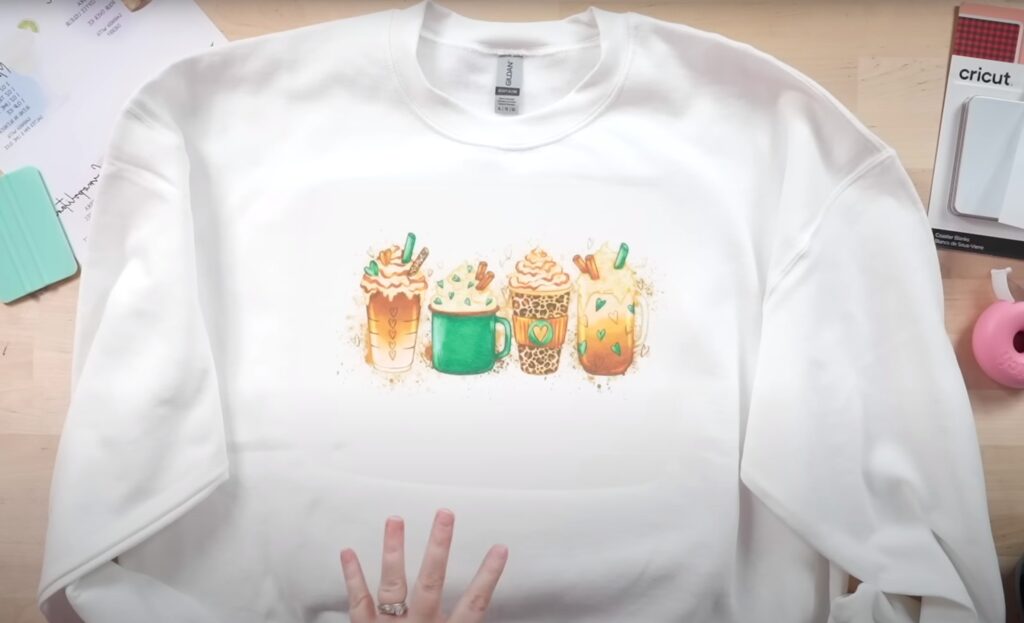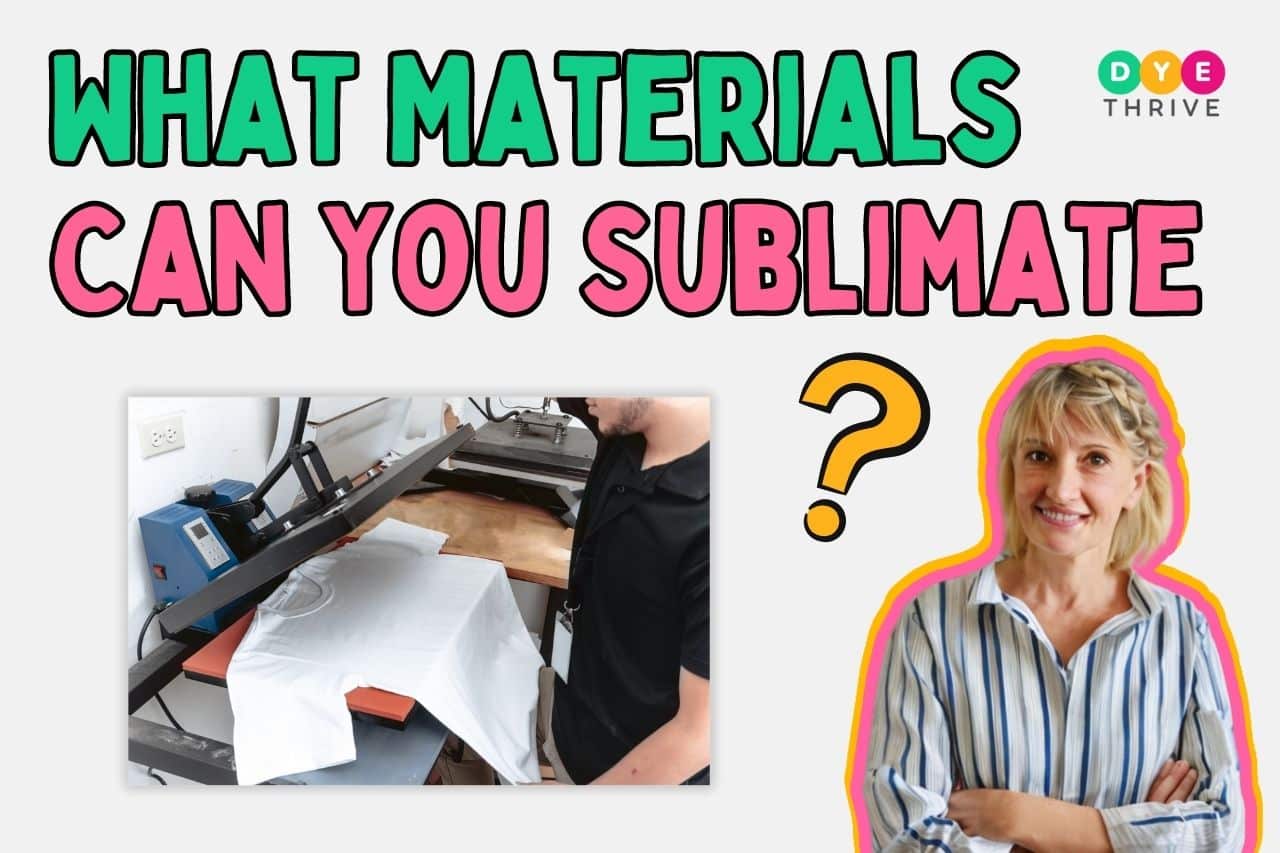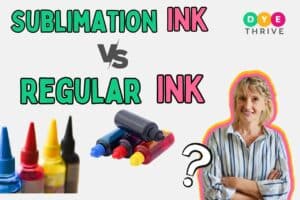If you’re new to sublimation printing, you may be wondering – what the heck can I even sublimate on??
I remember asking myself that same question when I first got started down this craft rabbit hole.
Sublimation can feel a little like magic. You take a blank item, print some design on paper, heat it up, and suddenly you have a fully customized creation! Wild right?
But how does it actually work?
And what materials play nice with those magical dyes? Grab a snack and get comfy, we’re going to unpack all of that today!
How Sublimation Printing Works
Let’s start at the very beginning – how does sublimation turn plain blanks into customized masterpieces?
Here’s the quick science behind it:
Sublimation printing uses heat to infuse printed dyes into materials.
When you apply high heat and pressure, a few things happen:
- The material on the blank expands slightly and opens up teeny tiny pores.
- The sublimation ink turns into a gas due to the intense heat.
- The pores in the material absorb the gaseous dye.
- As the material cools, the pores close up and lock the dye in place.
So unlike other printing methods that leave ink sitting on top of the material, sublimation infuses it directly into the core.
The dyes bond at a molecular level, which is why sublimated prints become a permanent part of the blank.
This leads us to the next question – what types of materials play well with sublimation? What will eagerly absorb those dyes and what will reject them?
What Materials Can You Sublimate On
When it comes to effortless sublimation prints, you want to stick with polymers and polymer-coated items.
These materials easily fuse with sublimation dyes to yield stunning results.
Here is a quick table that talks about every material types and their relation with sublimation.
| Material | Notes |
|---|---|
| Polyester Fabric | Works perfectly for sublimation. Opt for tightly woven polyester. Lower temp and longer duration works best. |
| Spandex, Lycra | Can be sublimated but colors won’t be as vibrant as polyester. Use stretchable heat tape to avoid distortion. |
| Acrylic | Can be sublimated but runs risk of melting. Use lower temp and quicker pressing time. Test on scraps first. |
| Vinyl | Can be sublimated but high risk of melting. Start at low temp and short duration, increasing slowly as needed. |
| Ceramic Mugs | Aluminum is pre-coated for full-color sublimation. Avoid overheating as it can damage the coating. |
| Metal Prints | Can be sublimated but runs the risk of melting. Use lower temp and quicker pressing time. Test on scraps first. |
| Plastic Blanks | Come pre-coated so they can be readily sublimated. Wrap a towel around the mug if the edges start to fade. |
| Wooden Items | Require polymer coating first to properly absorb dyes. Coat with polycrylic or heat lamination sheets before pressing. |
| Thermal Adhesives | Pre-coated for easy sublimation but can melt if overheated. Lower temp and moderate duration are best. |
| Ribbons | Allow sublimation onto other materials. Apply pressure evenly to avoid an uneven transfer. |
| Faux Leather | Can be readily sublimated but use gentle pressure and lower heat to avoid damage. |
| Cotton, Wool | Do not sublimate! Fibers do not bond with dye. Prints will fade and wash off. |
| Uncoated Wood | Extremely difficult to sublimate without pre-coating. Avoid unless willing to prep and risk poor results. |
1. Polymer Fabrics ( Sublimation’s BFF)
Polymers are synthetic materials made from long chains of molecules. You’ve probably worn polymers like polyester athletic clothes or spandex yoga pants!
The chemical structure of polymers makes them extra receptive to bonding with sublimation dyes. When heated, the polymers expand and readily soak up those gaseous inks into the core fibers.
Polyester is #1 for Sublimation
Polyester fabric is by far the most popular material for sublimation. It’s kinda like the gold standard.
When I first started, I stuck with 100% polyester blanks because I knew they would turn out great every time.

The weave matters too – tightly woven polyester works better than loose knits. The tighter weave doesn’t allow as much dye to escape.
I’ve sublimated on tons of polyester stuff over the years:
- T-shirts
- Hats
- Sweatshirts
- Scarves
- Towels
- Tote bags
- Flags and banners
Really, the possibilities with polyester are endless!
It’s always my number one recommendation for beginners.
Flexible Synthetics Like Spandex and Nylon
If you want prints that can stretch and move, spandex and nylon fabrics are great too. I like using them for:
- Sportswear like jerseys or yoga pants
- Swimwear and athletic shorts
- Sock designs
- Stretchy hair scrunchies
The results aren’t quite as perfect as polyester. But after some trials with time and temp, I’ve gotten awesome vibrant sublimation on all sorts of stretchy synthetics.
What About Acrylic and Vinyl?
These plastics can be trickier for sublimation since they melt easily. But with careful application of heat, they can turn out some pretty rad prints!
I’ve had the best luck using them for:
- Superhero logos and lunar landers on acrylic keychains
- Vintage album covers sublimated onto vinyl records to make wall art
With acrylics and vinyls, test on scraps first to dial in the ideal time and temp. You want the perfect balance to infuse the inks without melting the material.
Avoid Natural Fabrics Like Cotton and Wool
I know it stinks, but natural fabrics like cotton and wool are a no-go for sublimation. Bummer right?
The natural fibers in materials like cotton, linen, and wool don’t properly bond with sublimation dyes.
If you try to sublimate them, the prints come out super faded and blurry.
Then they just wash right off!
I made that mistake when I was just starting out. I printed a cute dachshund pattern on some cotton hand towels.
They turned out horribly – I could barely even see the designs. What a waste of time and supplies!
So do yourself a favor and just say no to natural fibers.
I know cotton is crazy popular, but it just doesn’t work for sublimation.
Polyester is your bestie!
2. Polymer-Coated Items
Many products are coated with a thin layer of polymer to prep them for sublimation. These tend to yield awesome results with very little effort!
a) Ceramic Coffee Mugs
My favorite easy project is sublimating ceramic mugs. They’re coated with a polyester layer that allows the dyes to go on smoothly and brightly.
Last Christmas, I made customized mugs for all my coworkers with cute pictures of their pets. They loved them!
b) Tumblers
Other popular items to sublimate are stainless steel tumblers and water bottles.
Most metal tumblers are coated with a polymer lining that allows for vibrant, full-wrap sublimation printing.

I love making custom skinny tumblers for my friends’ birthdays and holidays. The metallic sheen pairs so nicely with the colorful prints.
One tip if you make tumblers – watch the top and bottom edges during pressing.
These can fade a bit if they don’t have enough direct contact with the heat plates. If you notice fading, you can wrap a hand towel around the tumbler ends to protect them for more even heating.
But overall, metal tumblers yield awesome sublimated prints with very little fuss!
c) Plastic Plaques and Signs
Many plastic sign blanks are also pre-coated with polymer for easy sublimating. I use them to make:
- Engraved-style plaques for awards and retirements
- Motivational quote signs to decorate my house
- Cheerful welcome signs for family gatherings
d) Wooden Ornaments and Decor
Real wood doesn’t sublimate well on its own. But you can find wood products pre-treated with a polymer coating that prepares them to absorb dye.
Last Thanksgiving, I made custom tree-shaped ornaments with my family members’ names. They looked so nice on the branches!
Unconventional Materials to Test for Sublimation
Polymer fabrics and coated items are sure bets, but don’t be afraid to get creative and test other materials too! You never know what you may discover.
1. Thermal Adhesive Sheets
These special polymer sheets act as a dye carrier. You can sublimate your image onto the adhesive first, then apply the print wherever you want – wood, plastic, glass, metal, and more!
It takes some finessing to get the hang of adhesive sheets. But they open up a ton of unconventional surfaces to sublimate on. Definitely give them a try if you want to get more experimental!
2. Polyester Ribbon
Using sublimation dyes on polyester ribbon is an easy way to make personalized garments and accessories.
Some ideas:
- Sashes and ribbons for bouquets
- Monogrammed hair ribbons
- Custom ties and shoelaces
- Unique leashes with pet names
The satin finish on most ribbons takes the colors beautifully. And they add a fun pop of color to any project.
3. Faux Leather
Here’s a cool hidden gem – many faux leather goods are actually made of polymers so they happily accept sublimation dyes!
I’ve made awesome custom prints on:
- Faux leather phone cases
- Wallets and purses
- Notebook covers
- Yoga mats
Real leather is a no-go, but faux leather opens up so many possibilities. Give it a shot next time you find faux leather items on sale!
Challenging Materials for Sublimation
I promise we’re almost done with this material deep dive! But let’s chat quickly about a few tricky items that can give you grief with sublimation:
1. Natural Wood
Real wood contains oils, pockets of sap, and all sorts of organic quirks that make it resistant to sublimation. You can coat and prep natural wood to take dye, but it’s tricky.
If you want to sublimate on real wood, research products like polycrylic sealant. But know that it takes a lot of prep work and results can be hit or miss.
2. Acrylics and Vinyl
Like we talked about earlier, these plastics can totally melt under too much heat and pressure. It takes experimenting to get the process dialed in just right.
Make sure you have good temperature regulation in your heat press. And start with low temps and short durations for test prints. Slowly adjust until you get vibrant transfers without melting your blanks.
3. Miscellaneous Uncoated Items
Before sublimating on any bare wood, plastic, glass, or metal, do a little Googling to see if others have had luck with it. Many items need to be pre-coated or prepped to accept dye.
If an item isn’t specifically designed for sublimation, assume it won’t work until proven otherwise! Spend some time researching before wasting money on blanks and supplies.
Alrighty, we made it through the material rundown! Let’s wrap this up…
Final Tips for Sublimation Success
Hopefully you now have a solid grasp on the best materials to use with sublimation printing. To recap, here are my top tips:
- Stick with polyester for perfect results – It bonds beautifully with sublimation dyes every single time.
- Try polymer-coated items – They’re engineered for fast, vibrant transfers that come out great for beginners.
- Get your temps and times right – This takes some tests, but proper heat and duration is essential.
- Research unfamiliar materials – Some work great but many need special prep or coatings first. Homework pays off!
- Take notes and have fun – Tracking your results will help refine your technique. And play around with different materials to uncover new possibilities!
And feel free to reach out if you have any other sublimation questions come up. I’m always happy to chat!




